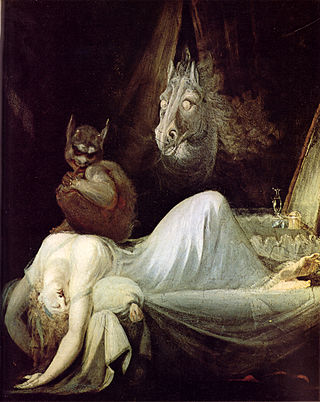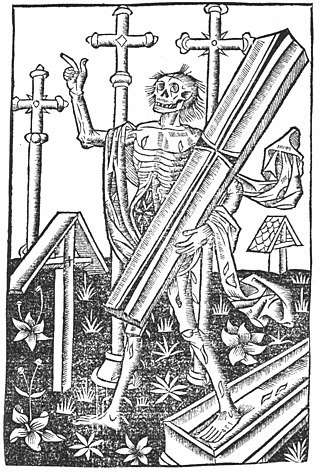
The aufhocker or huckup is a shapeshifter in German folklore.

The aufhocker or huckup is a shapeshifter in German folklore.
The Aufhocker is described in German legend as having an unidentifiable shape because it takes on shapes such as a goblin, a beautiful woman, a dead man, or various animals. [1]
The name Aufhocker means "leap upon". This name is used because according to legend, the Aufhocker would leap upon the back of its victims [2] which are often thieves and criminals that need to be taught a lesson. [3] Other common targets in the Aufhocker legend are lone travelers and old women.
The Aufhocker is known as a pressure spirit or perching spirit because it jumps on the backs of travelers weighing them down with every step. The victims often die of exhaustion because the Aufhocker cannot be shaken off or killed. However, it is believed that travelers can free themselves if they are able to make it home before being killed. [1] These attacks often occur in specific locations such as bridges, crossroads, springs, woods, on a path through a hollow, and cemeteries. [1]
The Aufhocker is a very dangerous theriomorph that is sometimes said to tear out the throats of humans instead of killing its victims from exhaustion. [4] The version of the Aufhocker that attacks victims' throats is linked to vampirism. In vampire mythology, sunlight and church bells are often used to frighten vampires away and may be applicable defenses against the Aufhocker also.
The Aufhocker legend is sometimes interpreted a metaphor for emotional burdens weighing on one’s shoulders no matter how hard they try to shake off their memories. The old woman that is a victim in some version of the legend represents time itself. The old woman is scared of getting older and has more memories to haunt her. Some other speculators say the Aufhocker legend is instead a materialization of Night Terrors. [3]
Similar myths can be found in most of Europe. In the Charente-Maritime département of France, the Ganipote is depicted as having similar traits. [1] In the formerly German-speaking parts of Bohemia, the same is attributed to the Uhaml. [5]

A vampire is a mythical creature that subsists by feeding on the vital essence of the living. In European folklore, vampires are undead creatures that often visited loved ones and caused mischief or deaths in the neighbourhoods which they inhabited while they were alive. They wore shrouds and were often described as bloated and of ruddy or dark countenance, markedly different from today's gaunt, pale vampire which dates from the early 19th century. Vampiric entities have been recorded in cultures around the world; the term vampire was popularized in Western Europe after reports of an 18th-century mass hysteria of a pre-existing folk belief in Southeastern and Eastern Europe that in some cases resulted in corpses being staked and people being accused of vampirism. Local variants in Southeastern Europe were also known by different names, such as shtriga in Albania, vrykolakas in Greece and strigoi in Romania.

In folklore, a werewolf, or occasionally lycanthrope is an individual who can shape-shift into a wolf, either purposely or after being placed under a curse or affliction, with the transformations occurring on the night of a full moon. Early sources for belief in this ability or affliction, called lycanthropy, are Petronius (27–66) and Gervase of Tilbury (1150–1228).

The Curupira is a mythological creature present in the Tupi-Guarani myths in the Amazon rainforest of Brazil.
A shtriga is a vampiric witch in Albanian mythology and folklore that sucks the blood of infants at night while they sleep, and then turns into a flying insect. Only the shtriga herself could cure those she had drained. The shtriga is often pictured as a woman with a hateful stare and a horribly disfigured face. They usually live in hidden places in the forest and have supernatural powers. The term shtriga is used also with the common meaning of "witch", referring to a bad and ugly old woman who casts evil spells upon people. The male noun for shtriga is shtrigu or shtrigan.

The each-uisge is a water spirit in Scottish folklore, known as the each-uisce in Ireland and cabbyl-ushtey on the Isle of Man. It usually takes the form of a horse, and is similar to the kelpie but far more vicious.
The Churel, also spelled as Charail, Churreyl, Chudail, Chudel, Chuṛail, Cuḍail or Cuḍel, is a mythical or legendary creature resembling a woman, which may be a demoniacal revenant said to occur in South Asia and Southeast Asia, particularly popular in India, Bangladesh, Nepal and Pakistan. The churel is typically described as "the ghost of an unpurified living thing", but because she is often said to latch on to trees, she is also called a tree-spirit. According to some legends, a woman who dies during childbirth or pregnancy or from suffering at the hands of her in-laws will come back as a revenant churel for revenge, particularly targeting the males in her family.

There are many Malay ghost myths, remnants of old animist beliefs that have been shaped by Hindu-Buddhist cosmology and later Muslim influences, in the modern states of Brunei, Indonesia, Malaysia, Singapore and among the Malay diaspora in neighbouring Southeast Asian countries. The general word for ghost is hantu, of which there exist a wide variety. Some ghost concepts such as the female vampires pontianak and penanggal are shared throughout the region. While traditional belief does not consider all ghosts as necessarily evil, Malaysian popular culture tends to categorise them all as types of evil djinn.

An Alp is a supernatural being in German folklore.

Brazilian mythology is the subset of Brazilian folklore with cultural elements of diverse origin found in Brazil, comprising folk tales, traditions, characters and beliefs regarding places, people, and entities. The category was originally restricted to indigenous elements, but has been extended to include:
The killer in the backseat is an urban legend from the United States and United Kingdom. It was first noted by folklorist Carlos Drake in 1968 in texts collected by Indiana University students.

The Patasola or "single leg" is one of many legends in South American folklore about female monsters from the jungle, appearing to male hunters or loggers in the middle of the wilderness when they think about women. The Patasola appears in the form of a beautiful and seductive woman, often in the likeness of a loved one, who lures a man away from his companions deep into the jungle. There, the Patasola reveals her true, hideous appearance as a one-legged creature with ferocious vampire-like lust for human flesh and blood, attacking and devouring the flesh or sucking the blood of her victims.
The tiyanak is a vampiric creature in Philippine mythology that takes on the form of a toddler or baby. Although there are various types, it typically takes the form of a newborn baby and cries in the jungle to attract unwary travelers. Once it is picked up by an unfortunate passerby, it reverts to its true form and attacks the victim. The tiyanak is also depicted to take malevolent delight in leading travelers astray, or in abducting children.

Colombian folklore are beliefs, customs and cultural traditions in Colombia.

Legends of vampires have existed for millennia; cultures such as the Mesopotamians, Hebrews, ancient Greeks, and Romans had tales of demonic entities and blood-drinking spirits which are considered precursors to modern vampires. Despite the occurrence of vampire-like creatures in these ancient civilizations, the folklore for the entity known today as the vampire originates almost exclusively from early 18th-century Southeastern Europe, particularly Transylvania as verbal traditions of many ethnic groups of the region were recorded and published. In most cases, vampires are revenants of evil beings, suicide victims, or witches, but can also be created by a malevolent spirit possessing a corpse or a living person being bitten by a vampire themselves. Belief in such legends became so rife that in some areas it caused mass hysteria and even public executions of people believed to be vampires.

The name Wiedergänger refers to different zombie or ghost phenomena from different cultural areas. The word means "one who walks again" in German. The core of the wiedergänger myth is the concept of the deceased, who—often in the form of a physical phenomenon—return to the world of the living. They usually cause problems and frighten living people. They exist either to avenge some injustice they experienced while alive, or because their soul is not ready to be released, as a consequence of their former way of life.
Daayan, Ḍāin or Ḍāini is often mistakenly regarded as a Bandariya for a witch in Indian folklore, the term has been derived from the Sanskrit word dakini, which refers to a female paranormal entity from patala. Dakinis have been described in medieval Hindu texts such as the Bhagavata Purana, Brahma Purana, Markandeya Purana and Kathasaritsagara as female fiendish spirits in the train of Kali who feed on human flesh.
Buso is a generic term for demons or evil spirits in the folklore of the Bagobo peoples. They typically prey upon flesh and send diseases to kill unsuspecting humans. Shrines and offerings would be made to the buso in an attempt to deter them from attacking. They are sometimes associated with tebang and burkan, the ghosts of evil souls.
The Uhaml is a spirit from German folktales. It was known among the former Germans of Bohemia and Silesia, now part of the Czech Republic and Poland respectively, particularly in the former Iglau language island of Bohemia. The Uhaml is an airy sprite, a ghost, or possibly some kind of demonic bird. Nothing is known about its appearance other than it having horse feet.